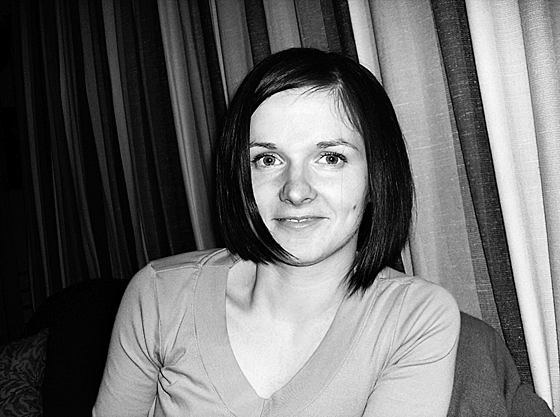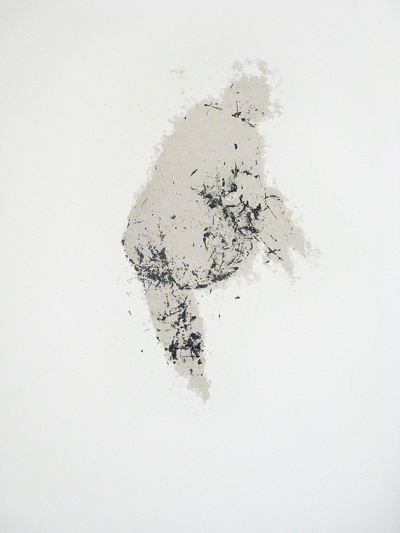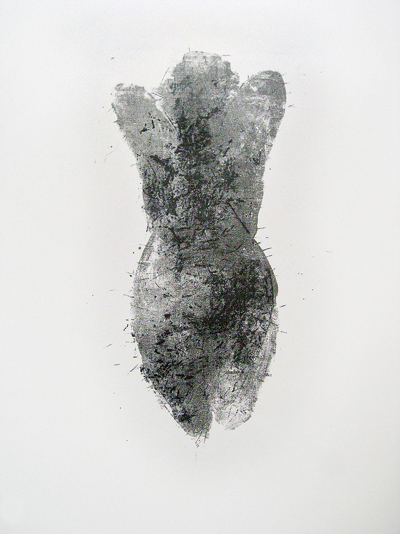|
|
| Kristīne Lasmane Dita Birkenšteina, Student, Art Academy of Latvia | |
| Kristīne Lasmane (born 1981) is a master’s student in the Graphics Department of the Art Academy of Latvia. Over the last few years she has participated in more than ten group exhibitions, offering to the public not only works of graphic art, but also installations. Prior to her studies at the Art Academy, Kristīne obtained a bachelor’s degree and a qualification in visual art and art history education from the Faculty of Education and Psychology at the University of Latvia (2008). | |
 Kristīne Lasmane. 2011 Photo from the private archive of Kristīne Lasmane | |
| Kristīne’s works are of a very personal nature and deal with physically and emotionally intimate themes. One of the most extensively explored themes in her graphic art works is skin, which, according to the artist, has a great capacity for revealing individual bodily features and describing a person. Themes such as nudity, age and ageing are directly predicated on it. Kristīne’s family also has an important role in her creative work, and often her family members are the people whose features or skin structure peculiarities are revealed in Kristīne’s graphic works. Engraving is the form of printmaking in which Kristīne expresses herself the most freely, and the young artist greatly values all the stages of production of the impression, as well as the lively nature of this art form which doesn’t permit a detailed prediction of the result. So that the art work doesn’t lose contact with the author, and hence some of its value, Lasmane considers that, for her, an independent working process from the sketch to the finished set of prints (without any involvement from a master printmaker) is vital. The series of works in which the “skin” theme is used is Kristīne’s bachelor’s degree work Membrāna (‘Membrane’, 2010), a fourteen lithograph cycle supplemented by a video installation portraying naked women’s bodies, visualizing the sensations caused by the skin’s reaction to heat and being beaten with bundles of leafy twigs or brushes during the cleansing process in a sauna. The compositions are ascetic, the attention is focussed on a classical academic staple – the nude, but the interest in ‘Membrane’ lies in its technical execution. | |
| While working on this cycle, the artist has played around with the printing technique. As opposed to the usual lithographic working process in which compositions appear immediately on the lithographic stone, Kristīne has created these on paper with a gum arabic overlay which she’s transferred to the surface of the stone. Using this method, the imprints from the colour create painting-like textures, and the vital crackles of colour allow one to sense the wood humming in the fire and to feel the tingle on the skin created by the juniper sauna brushes. Like many young artists, Kristīne experiments with the possibilities afforded by various techniques and means of expression. These creative searches have resulted in works which could theoretically be called drawings, but where pencil lines have been replaced by metal staples, similarly as can be seen in the work Aggravure (2007–2011) by French artist Baptiste Debombourg, in which the metallic sparkling of the staples has an essential role in creating a reference to Mannerist prints. Kristīne’s work Skavu čuksti (‘Whispers of Staples’, 2010) presents a scene with holidaymakers lazing in a pine forest, among them the artist’s grandmother and her son, and through the vibrating and sparkling metal “strokes” of the staples the artist has been able to create the illusion of the dry rustling of pine needles. The experiments commenced with staple strokes were followed by a series of small-sized prints, portraits of people close to the author, whose individual skin features are examined and captured in close-up. On this series Kristīne worked in mixed engraving techniques, also using frottage, where an imprint of the metal staples has been transferred to paper in relief. The way in which the staple frottage scarifies the compositions, taking on a life of their own, can best be seen in the portrait of a man Bārda (‘Beard’, 2010), where the tiny staple marks mixing with the thick stubble created by a dry needle convincingly materialize into a man’s beard. | |
 Kristīne Lasmane. Membrane 9. Dichromatic lithography. 64x46 cm. 2011 | |
| Very recently at the Academy Kristīne organized an interactive art happening Velna dancis vecmāmiņas stāstos (‘Dancing with the Devil in Grandmother’s Stories’, 2012), which involved the creation of a large format drawing. The inspiration for it was childhood memories of her grandmother telling her adventure stories before she went to sleep, in which images from folklore were woven with fantasy. A large piece of sketching paper was laid out on the floor, on which little devils were deftly created using coal and ash dust, and passers-by were invited to join in the dance so that they, too, wearing fleece slippers, could take part in the creation of the dance and the drawing. The event was filmed on video. Despite printmaking’s specific attachment to flat surfaces, Kristīne is not afraid of working with spatial objects and creating installations as well. With one of these she took part in the Zilā zeme (‘Blue Land’) exhibition at the Latvian Museum of Naïve Art organized by students from the Graphics Department. The motto of the exhibition was “Green Land… Blue Sea… Art as Life’s Naivety”, and models of contemporary lifestyles and systems which are accepted as the norm were analysed in thirteen student projects. The installation Galds (‘Table’, 2012) was created as a reference to a statement by education researcher Ken Robinson, who said that the modern-day education system model is comparable to a fast food restaurant: programmes are standardized, instead of being adapted to local circumstances and needs, and as a result, in a similar way that the fast food system abuses the organism, the standardized education model impoverishes society’s capacity for thinking. At the same time, the artist draws parallels and compares fast food culture to the lifestyle of society as a whole – the fast pace doesn’t allow us to savour slowly anything of we do: we see it, gulp it down and keep on running. Kristīne’s installation is made up of a household dinner table covered by a long illuminated crepe paper table cloth. | |
 Kristīne Lasmane. Membrane 13. Dichromatic lithography. 92x64 cm. 2011 | |
| In continuing to explore the theme of skin as previously commenced, Kristīne created the installation Enerģētiskā čaula (‘Energetic Casing’, 2012). ‘Energetic Casing’ is the artist’s “skin” made of papier-mâché, illuminated by a warm glow from the light inside. Encoded in the “shell” of the paper mass are questions and reflections of importance to Kristīne about skin, not only as a vital, independently living and breathing organ, constantly subject to countless outside influences without losing the capacity to renew itself, but also as a casing that protects a person’s spiritual body. At a time when society is preoccupied by the problem of the world’s overpopulation, Kristīne draws attention to how much space a person takes up, and how much is taken by a family or a nation, and how this appears when projected onto the plane, also what sort of energy and warmth is radiated by a person. These and other reflections are the values which impart ‘Energetic Casing’ such a wealth of content. Perhaps uncharacteristically for a printmaker – Kristīne Lasmane sees and plans creative ideas spatially, and therefore actively addresses ideas of how to liberate and enliven printmaking through bringing it into our daily environment. This leads us to think that original art projects can be expected from her in the future. Translator into English: Uldis Brūns | |
| go back | |







